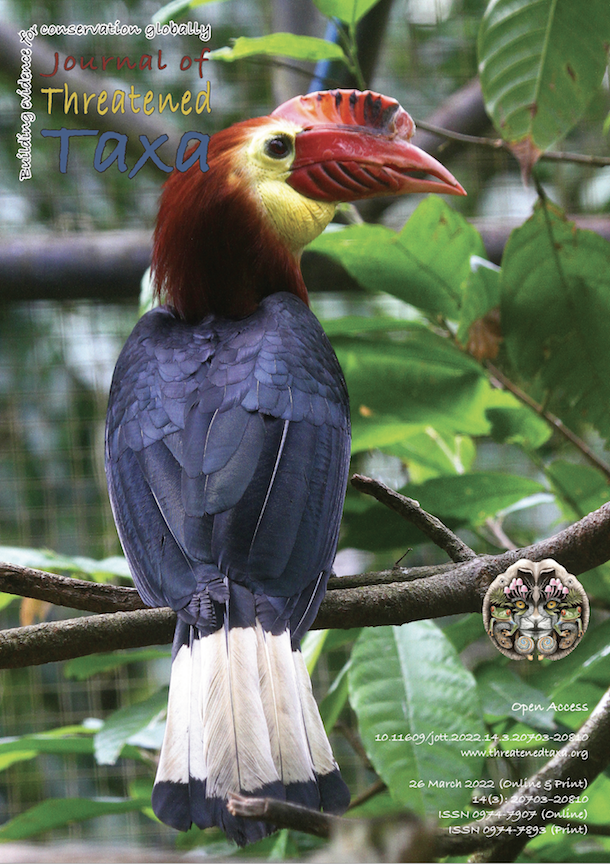Breeding biology of Sri Lanka White-eye Zosterops ceylonensis (Aves: Passeriformes: Zosteropidae) in tropical montane cloud forests, Sri Lanka
Main Article Content
Abstract
Breeding biology of the endemic Sri Lanka White-eye Zosterops ceylonensis was studied from January 2017 to January 2018 in the montane cloud forests of Horton Plains National Park, in Nuwara Eliya District of Sri Lanka. A total of 46 active nests were studied. Breeding occurred March–May. The peak egg-laying was in March and April. Mean nest construction period 11±2.87 days (n= 17), nest height was 3.16±1.22 m from the ground. Majority of nests were built on Sarcococca brevifolia, Berberis ceylanica, and Cinnamomum ovalifolium trees of 4–12 m tall. Most number of pen cup nests were constructed by the fine grass stalks and mosses woven with cobwebs and internal cup lined with grass roots. Eggs were pale blue. Mean clutch size 2.15±0.37 eggs (n= 11). The incubation period was 10.92±0.9 days (n= 11). Nestling period was 28.33±1.55 days (n= 11). Both sexes participate in nest construction, incubation and brood rearing. About 25.53% of nests were depredated (N= 12). The overall nest success was 74.46%. The study reveals that undisturbed cloud forests are critical to conservation of Sri Lanka White-eye.
Article Details

This work is licensed under a Creative Commons Attribution 4.0 International License.
Authors own the copyright to the articles published in JoTT. This is indicated explicitly in each publication. The authors grant permission to the publisher Wildlife Information Liaison Development (WILD) Society to publish the article in the Journal of Threatened Taxa. The authors recognize WILD as the original publisher, and to sell hard copies of the Journal and article to any buyer. JoTT is registered under the Creative Commons Attribution 4.0 International License (CC BY), which allows authors to retain copyright ownership. Under this license the authors allow anyone to download, cite, use the data, modify, reprint, copy and distribute provided the authors and source of publication are credited through appropriate citations (e.g., Son et al. (2016). Bats (Mammalia: Chiroptera) of the southeastern Truong Son Mountains, Quang Ngai Province, Vietnam. Journal of Threatened Taxa 8(7): 8953–8969. https://doi.org/10.11609/jott.2785.8.7.8953-8969). Users of the data do not require specific permission from the authors or the publisher.
References
Ali, S.L. & S.D. Ripley (eds.) (2001). Handbook of the Birds of India and Pakistan together with those of Bangladesh, Nepal, Bhutan, and Sri Lanka. Oxford University Press, Delhi, India.
Altmann, J. (1974). Observational study of behavior: Sampling methods. Behaviour 49: 227–267. DOI: https://doi.org/10.1163/156853974X00534
BirdLife International (2016). Zosterops ceylonensis. In: IUCN 2012. IUCN Red List of Threatened Species. 2012. Date of download 2019/01/28. https://doi.org/10.2305/IUCN.UK.2016-3.RLTS.T22714023A94397877.en DOI: https://doi.org/10.2305/IUCN.UK.2016-3.RLTS.T22714023A94397877.en
Burnham, K.K. (2007). Inter-and intraspecific variation of breeding biology, movements, and genotype in Peregrine Falcon Falco peregrinus and Gyrfalcon F. rusticolus populations in Greenland. PhD Thesis. University of Oxford.
Chandrasiri, P.H.S.P., W.D.S.C.Dharmarathne, S. Lakmal & W.A.D. Mahaulpatha (2017). Distribution of the jungle crow (Corvus levaillantii lesson, 1831) and their potential threats to biodiversity in Horton Plains National Park, Sri Lanka. Wildlanka 5(2): 073–077.
Clements, J.F., T.S. Schulenberg, M.J. Iliff, D. Roberson, T.A. Fredericks, B.L. Sullivan & C.L. Wood (2016). The Clements checklist of birds of the world. http://www.birds.cornell.edu/clementschecklist/download/Google Scholar.
Collias, N.E. & E.C. Collias (2014). Nest Building and Bird Behavior. Princeton University Press.
Conway, C.J. & T.E. Martin (2000). Evolution of passerine incubation behavior: influence of food, temperature, and nest predation. Evolution 54(2): 670–685. DOI: https://doi.org/10.1111/j.0014-3820.2000.tb00068.x
de Silva, A. (2007). The Diversity of Horton Plains National Park (with special reference to its herpetofauna). Vijitha Yapa Publishers. Sri Lanka.
Gunatilleke, C.V.S. & I.A.U.N. Gunatilleke (1986). Horton Plains: some aspects of its vegetation and ecology. Sri Lanka Wildlife 3(4): 9–11.
Henry, G.M. (1971). A Guide to the Birds of Ceylon (Second Edition). Oxford University Press, London, UK.
Horton Plains National Park (2010). International Water Management Institute. https://web.archive.org/web/20100805010613/http://dw.iwmi.org/wetland_profile/Horton.asp
BirdLife International (2009). IBAs in Sri Lanka. http://www.birdlife.org/datazone/country/sri-lanka.
Kozma, J.M & N.E. Mathews (1997). Breeding bird communities and nest plant selection in Chihuahuan Desert habitats in south-central New Mexico. The Wilson Bulletin 109(03): 424–436.
Krebs, J.R & N.B. Davies (2009). Behavioural Ecology: An Evolutionary Approach. John Wiley & Sons.UK.
Lack, D.L. (1971). Ecological Isolation in Birds. Harvard University Press, Cambridge, Massachusetts, USA.
Skutch, A.F. (1976). Parent Birds and Their Young. Austin and London: University of Texas Press.
Struhsaker, T.T. (1975). The Red Colobus Monkey. University of Chicago Press, Chicago, 311pp.
Sutherland, W.J., I. Newton & R. Green (2004). Bird Ecology and Conservation: A Handbook of Techniques (No. 1). Oxford University Press. DOI: https://doi.org/10.1093/acprof:oso/9780198520863.001.0001
Wait, W.E. (1922). The Passerine Birds of Ceylon. Spolia Zeylanica 12: 182. DOI: https://doi.org/10.5962/bhl.title.14983
Zollner, P.A. & K.J. Crane (2003). Influence of canopy closure and shrub coverage on travel along coarse woody debris by eastern chipmunks (Tamias striatus). The American Midland Naturalist 150(1): 151–157. DOI: https://doi.org/10.1674/0003-0031(2003)150[0151:IOCCAS]2.0.CO;2

